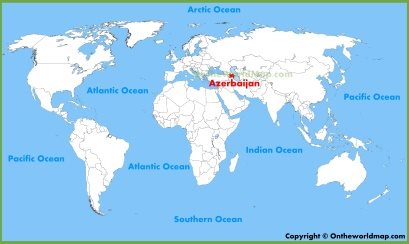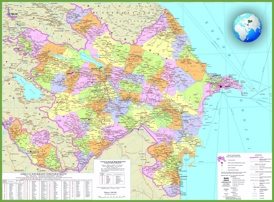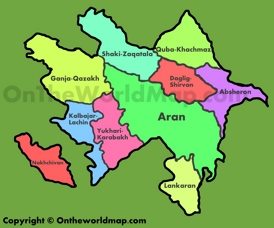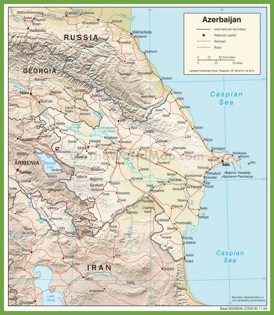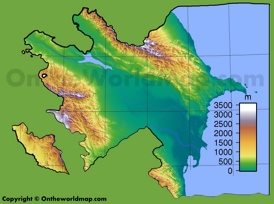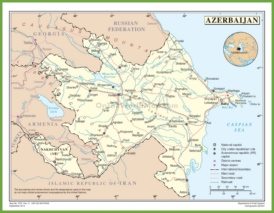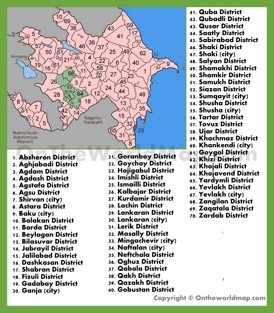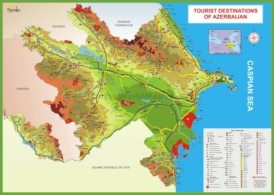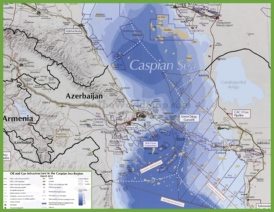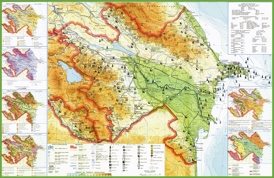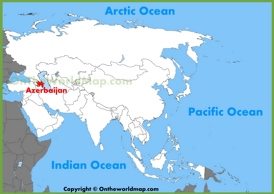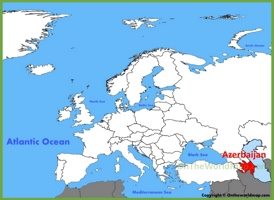Azerbaijan Map
Description:
This map shows governmental boundaries of countries; Nakhchivan Autonomous Republic, major cities and towns in Azerbaijan.
Size: 1700x1410px / 369 Kb
Author: Ontheworldmap.com
previous version of this map
You may download, print or use the above map for educational, personal and non-commercial purposes. Attribution is required. For any website, blog, scientific research or e-book, you must place a hyperlink (to this page) with an attribution next to the image used.
Online Map of Azerbaijan
About Azerbaijan
Azerbaijan occupies a strategic position at the junction of Eastern Europe and Western Asia. It borders Russia to the north, Georgia to the northwest, Armenia to the west, Iran to the south, and the Caspian Sea to the east.
Baku, the capital of the country, is the largest city and serves as the main political, economic and cultural center. Other significant cities include Ganja, Sumgayit and Mingachevir, which play an important role in the country's industrial and economic activities.
Azerbaijan's economy is primarily dependent on its significant oil and natural gas reserves, which contribute significantly to national income and export earnings. The government has made efforts to diversify the economy by developing sectors such as agriculture, manufacturing and information technology. These initiatives are aimed at reducing dependence on the oil sector and ensuring sustainable economic growth.
Azerbaijan also pays great attention to the development of the tourism industry, attracting tourists with a combination of modern and historical attractions. Baku is home to modern architectural attractions such as the Flame Towers and the Heydar Aliyev Center, while the Old City offers a taste of history. Natural attractions include Gobustan National Park, famous for its ancient rock paintings, and unique mud volcanoes. The mountains of the Greater Caucasus and the Caspian Sea are additional scenic spots. Through infrastructure development and investment, Azerbaijan is striving to increase its attractiveness as a tourist destination, contributing to the diversification of the economy.
The Facts:Capital: Baku.
Area: 33,400 sq mi (86,600 sq km).
Population: ~ 10,200,000.
Largest cities: Agdash, Aghjabadi, Agstafa, Agsu, Astara, Aghdara, Babek, Baku, Balakən, Barda, Beylagan, Bilasuvar, Dashkasan, Shabran, Fuzuli, Gadabay, Ganja, Goranboy, Goychay, Goygol, Hajigabul, Imishli, Ismayilli, Jabrayil, Julfa, Kalbajar, Khachmaz, Khankendi, Khojavend, Khirdalan, Kurdamir, Lankaran, Lerik, Masally, Mingachevir, Nakhchivan, Naftalan, Neftchala, Oghuz, Ordubad, Qabala, Qakh, Qazakh, Quba, Qubadli, Qusar, Saatlı, Sabirabad, Shahbuz, Shaki, Shamakhi, Shamkir, Sharur, Shirvan, Siyazan, Shusha, Sumgait, Tartar, Tovuz, Ujar, Yardimli, Yevlakh, Zaqatala, Zardab, Zangilan.
Official language: Azerbaijani.
Currency: Manat (₼) (AZN).
Economic Regions of Azerbaijan: Absheron, Aran, Mountainous Shirvan, Ganja-Qazakh, Quba-Khachmaz, Kalbajar-Lachin, Lankaran, Nakhchivan, Shaki-Zagatala, Upper Karabakh.
Driving side: right.
Calling code: +994.
Internet TLD: .az.
Time zone: UTC+4 (AZT).
Google Map of Azerbaijan
Geography of Azerbaijan
Azerbaijan, located at the junction of Eastern Europe and Western Asia, is characterized by a variety of geographical regions, including the mountain ranges of the Greater and Lesser Caucasus, the Caspian Sea coast and the central lowlands.
The country's climate is diverse and depends on topography and location. In coastal areas along the Caspian Sea, a semi-arid climate prevails, characterized by mild winters and hot, dry summers. In contrast, mountainous areas have a more temperate climate with lower temperatures and more precipitation, especially in the Greater Caucasus. Lowland areas, including the Kura-Aras Plain, have a continental climate characterized by hot summers and cold winters. This climatic diversity supports different ecosystems and agricultural activities in different regions of Azerbaijan.
Brief History of Azerbaijan
The history of Azerbaijan reflects the complex interaction of different empires and cultures due to its strategic location. Ancient tribes inhabited the region, which was later influenced by the Persian Empire. In the 4th century, the spread of Christianity marked a significant cultural shift. In the 7th century, the Arab Caliphate introduced Islam, which became the dominant force. The Seljuk Turks, Mongols, and Safavids successively ruled the area, each leaving behind notable cultural and political traces.
In the 19th century, the Russian Empire absorbed Azerbaijan, which led to the development of industry, especially oil. Azerbaijan briefly declared independence in 1918 and was incorporated into the USSR in 1920. The country regained its independence in 1991 after the collapse of the Soviet Union. Since then, Azerbaijan has focused on economic development and navigating regional geopolitical dynamics.


